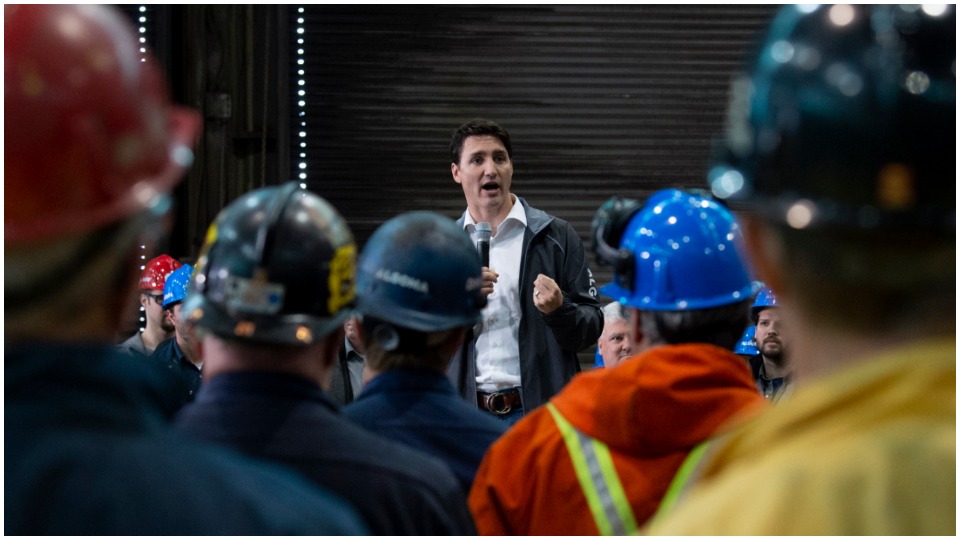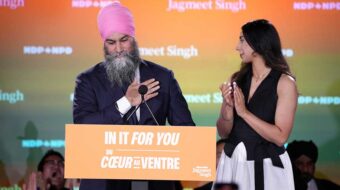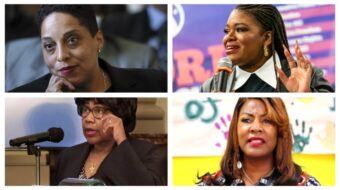
TORONTO—Justin Trudeau won in 2015 on a left-leaning platform filled with pledges to tax the rich, make elections more democratic, and save the world from climate change. But four years, a number of scandals, and several broken promises later, it’s getting harder for his Liberal Party to make Canadians think it’s the modern progressive force it claimed to be.
People here will be heading to the polls on Monday, Oct. 21, and although it looks for now as though the prime minister will hold onto his position, it’s becoming increasingly possible that his commanding Liberal majority could at least shrink to a minority—and he may even have to rely on parties to the left to form a coalition government.
After almost a decade of Conservative rule—secured with the support of only around a third of the electorate—many Canadians in the last election wanted to give their votes to the one party they thought capable of getting rid of then-Prime Minister Stephen Harper. After soaring to second place in the 2011 vote, at first it looked as if the left-wing, labor-based New Democratic Party (NDP) would be that choice.
But just when they were poised to gain federal power for the first time, the social democrats of the NDP shifted to the center. The party’s turn toward so-called fiscal discipline and cautious public policy came at exactly the wrong time. Economic recession was on the horizon, and people wanted real change. Trudeau, who was then the third-place Liberals’ newly-minted leader, was much better at reading the electorate and openly embraced deficit spending and higher taxes to fund public needs.
He stole even more votes from the NDP and the nominally-progressive Green Party with a promise to bring in a proportional representation voting system and thus end the first-past-the-post privileges of the two major parties (Liberals and Conservatives).
The left Liberal
Once in office, the signals to the left kept flashing. Trudeau appointed a cabinet that was 50% women and the most ethnically diverse in the country’s history. An Indigenous woman was made attorney general, a turban-wearing Sikh man given the defense portfolio, and a Somali refugee put in charge of immigration. Formal government apologies were made to the LGBTQ and Indigenous communities in an attempt to right old wrongs. When it came to trade, he took a tough line publicly in the NAFTA re-negotiations, saying he was standing up for Canadian jobs and even getting U.S. trade unionists excited that Canada might be by their side in fighting right-to-work.
Income taxes were raised on the richest, as promised, with the top tax bracket (income over $200,000) notching up from 29% to 33% in 2016. The modest move was enough to send the conservative Frasier Institute into a panic about Canada’s “competitive disadvantage” compared to low-tax U.S. jurisdictions, but the top 1% figured out ways around the tax hikes (taking early dividends and other tricks) and actually saw their incomes climb while their tax burdens went down in 2017, according to analysis by the Canadian Press.

Many of the other promises which won Trudeau left and working-class votes fell by the wayside. Electoral reform never materialized (proportional representation had somehow become “harmful to Canada,” Trudeau told the CBC). The formula which provides federal funding for the province-based public health care system remained largely unchanged from the Harper years, despite the pledge of an updated accord.
A new carbon tax was pitched as a way to make polluters pay for the damage they do, but it ended up returning most of the cash to those same polluters through subsidies, showing the kind of absurdities common in market-based approaches to the environment. And when the Kinder Morgan corporation’s plans for the Trans Mountain oil pipeline crashed in the face of mass Indigenous resistance, Trudeau allocated $4.5 billion of public money to buy out the project. Trudeau’s participation in last month’s Global Climate Strike had many activists saying he was essentially protesting himself.
All that before even mentioning the arms sales to Saudi Arabia, which cut journalist Jamal Khashoggi to pieces and is executing an atrocious war that has killed tens of thousands in Yemen.
If the policy reversals and half-turns were not enough, the old Liberal Party penchant for public scandal also returned. His attorney general, Jody Wilson-Raybould, ended up resigning when she couldn’t abide by Trudeau’s apparent instructions to not pursue criminal charges against engineering firm SNC Lavalin. The corporation stands accused of bribery and corruption in not just Canada (where it apparently sent tens of thousands of dollars into Liberal Party coffers) but also more than 50 other countries.
Another scandal was the revelation that Trudeau donned racist blackface and brownface makeup multiple times in the past. The offenses exposed the racism that’s all-too-common among the upper crust of the ruling class and their political representatives, but the controversy also served to at least have some public discussion of the very real systemic racism that still exists in multicultural Canada. But a last-minute endorsement from former U.S. President Barack Obama was announced for good measure to prove Trudeau isn’t really a racist.
Which way for minority government?
As for the Conservative Party, it’s led by Harper clone Andrew Scheer, who hides a regressive big business agenda behind his bland and disarming persona. His biggest personal scandal so far has been the exposé that he was not really a licensed insurance broker, as he had claimed. The real scandal in the eyes of many activists, though, is his long record of opposing things like women’s reproductive freedom and LGBTQ equality.
Presiding over a divided party and facing a skeptical electorate, Scheer delayed releasing his party’s platform until late on the Friday night of a holiday weekend. He succeeded in burying the news that he planned more than $50 billion in cuts. By the end of the long weekend, there was little press coverage of his scheme to cut income taxes, eliminate the carbon tax, trim foreign aid by 25%, and freeze public service staffing levels while boosting military spending and—copying Trump—spending a few million to move Canada’s Israeli embassy to Jerusalem.

The Conservatives have the solid support of their base in the energy-rich provinces of the west and across the prairie, but Canada-wide, voters don’t seem to be swinging to the right in large numbers. At most, the Conservatives are hoping to win a minority government, but there are whispers that Scheer could have trouble holding onto his own parliamentary seat on Election Day.
The union-backed New Democrats, meanwhile, after being decimated last time around, are surprisingly experiencing a late campaign surge under new leader Jagmeet Singh. His pledge to add dental, vision, and prescriptions to Canada’s public health system and his handling of the Trudeau blackface/brownface scandal has many taking a second look at the first non-white leader of a major Canadian political party.
But for a labor-based party, commentators have remarked on the absence of any proposals in the NDP platform to revive the declining fortunes of trade unions. Though still high relative to the U.S., union membership has been trending downward, from nearly 40% in the early 1980s to just over 30% today—and only 16% in the private sector.

The Greens remain a persistent presence thanks to their capable leader and only Member of Parliament, Elizabeth May. With Trudeau’s federal Liberals and provincial-level New Democrats both enamored with oil pipelines as of late (Alberta’s NDP government parts ways with Singh on the Trans Mountain), the party continues to hold the least tarnished credentials when it comes to climate change.
Hardly worth mentioning except for the purposes of condemnation is the People’s Party of Canada. After former Foreign Affairs Minister Maxime Bernier failed to win the Conservative leadership, he formed his own anti-immigrant party which hopes to seal the borders and cut taxes even faster than the Republicans in the U.S. Though they are trying to mimic Trump’s success, Bernier and the PPC, thankfully, aren’t exciting too many people yet. The fact that he made it onto the debate stage and was able to field candidates across the country, however, signals there is a possible base for more extreme politics in Canada.
Quebec, which is a nation and political culture all its own, is seeing a political battle between the Liberals and the separatist Bloc Quebecois party. The Bloc, which has made hysteria around Muslim women’s headscarves its signature issue, is looking to return to the days when it held every seat in the province. If Trudeau loses his majority, it could very well happen in French Canada.
A “People’s Agenda”
The most detailed and consistent platform remains that of the Communist Party of Canada, which will unfortunately not be winning any seats in this election. It is running candidates in roughly 10% of the country, concentrated in urban areas. The Communists see the election of a “large progressive bloc” to deny “the big business parties a majority,” referring to the Liberals and Conservatives, as the best possible outcome. Slashing the military budget, increasing the stock of social housing, expanding public health care, and charting a Canadian foreign policy independent of the U.S. are a few among many goals in the party’s “People’s Agenda.”

Reversing Canada’s over-dependence on the U.S. economy and multinationals, like the Big 3 automakers, is another goal the Communists are pushing. Party leader Elizabeth Rowley told People’s World’s Mark Gruenberg in June, “Our economy is skewed because we’re next door to U.S. imperialism” and to U.S. politics. “They view us as a source for raw materials” such as aluminum and steel for cars and softwood lumber for homes, “and a market for finished products.”
None of the other parties talk much at all about strengthening Canada’s economic independence from the U.S. or any alternative to capitalism in Canada, where inequality is on the rise. The NDP dropped “socialism” from its constitution a few years back, and only the Communists are saying anything about a systemic alternative.
Those bigger concerns continue to take a back seat to the tinkering of today, though. With a Trudeau minority looking to be the likely outcome, there is a chance the NDP or even the Bloc Quebecois could end up holding the balance of power. If it’s the New Democrats, Trudeau may be pushed into enacting a few more of his past progressive promises. If it’s the Bloc, don’t expect as much. And of course, if Scheer’s Conservatives manage to pull off a win, it’s Harper 2.0.











